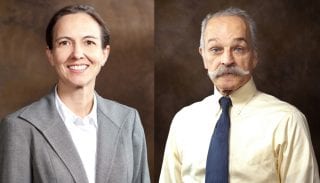Researchers Use Genetic Information to Track Chronic Wasting Disease in Deer
FAYETTEVILLE, Ark. – University of Arkansas researchers Marlis and Michael Douglas are using genetic information to implement the first statewide study of chronic wasting disease among white-tailed deer in Arkansas. Funded by a $200,000 grant from the Arkansas Game and Fish Commission, the study will identify how groups of deer are related to one another throughout the state and determine which populations are less susceptible to the disease.
Chronic wasting disease, or CWD, is an incurable, fatal, transmittable disease found in deer, elk and moose. It is caused by a deformed protein called a prion, similar to “mad cow” disease. Currently, there is no evidence that CWD is a threat to humans or livestock.
The disease was originally identified in Colorado in 1967 and was confirmed in an Arkansas deer for the first time in 2016. The most recent statistics from the state show that as of January 2018, there were 357 cases in deer and elk in 10 northern Arkansas counties, with the bulk of the infections occurring in Newton County.
The Douglases are leading the CWD study. Both are professors in the Department of Biological Sciences; Marlis holds the Bruker Professorship in Life Sciences, and Michael the 21st Century Chair in Global Change Biology. They and their graduate students, Tyler Chafin and Zach Zbinden, will perform DNA testing on 10 deer sampled per county in Arkansas, plus an additional 300 samples from the Arkansas Game and Fish Commission’s CWD Management Zone, a cluster of counties in the northern part of the state centered on Newton County. The tissue samples will be collected from deer harvested by hunters or killed in roadside accidents.
By determining how deer populations are related throughout the state, the researchers will acquire a clearer understanding of their movement patterns. “Understanding how deer disperse will give us an understanding of how the disease is spreading,” said Marlis Douglas. “That will help the AGFC develop management strategies that either facilitate movements among deer groups or prevent them, depending on the circumstances.”
While groups of deer often interbreed, geographic barriers such as rivers, interstate highways or elevation changes can keep deer herds from mixing, Douglas said. “This shows up in our genetic testing as populations being distinct from one another.”
Similar studies in other states have already shown that some deer populations carry a gene variant that may make them less susceptible to CWD. A previous study by the Douglases showed that the variant is present in some Arkansas deer. Resource managers will have powerful tools to help contain the disease when researchers have a clear understanding of how deer populations intermix and an idea which deer carry the gene variant.
Hunting contributes $1 billion annually in economic impact to the state, according to a 2011 survey by the U.S. Fish and Wildlife Service, so maintaining a healthy deer herd is also a strong economic consideration. “CWD will not disappear in the state,” Douglas said. “But we can provide scientific data to help AGFC manage the herd such that it is not decimated by the disease.”
The Department of Biological Sciences is part of the J. William Fulbright College of Arts and Sciences at the University of Arkansas.
About the J. William Fulbright College of Arts and Sciences: Fulbright College is the largest and most academically diverse unit on campus with 19 departments and more than 30 academic programs and research centers. The college provides the core curriculum for all University of Arkansas students and is named for J. William Fulbright, former university president and longtime U.S. senator.
About the University of Arkansas: The University of Arkansas provides an internationally competitive education for undergraduate and graduate students in more than 200 academic programs. The university contributes new knowledge, economic development, basic and applied research, and creative activity while also providing service to academic and professional disciplines. The Carnegie Foundation classifies the University of Arkansas among only 2 percent of universities in America that have the highest level of research activity. U.S. News & World Report ranks the University of Arkansas among its top American public research universities. Founded in 1871, the University of Arkansas comprises 10 colleges and schools and maintains a low student-to-faculty ratio that promotes personal attention and close mentoring.
This story originally appeared in the University of Arkansas’ Newswire publication. Please visit news.uark.edu for more stories like this.
Marlis R. Douglas
Professor, Department of Biological Sciences
479-575-7186 // liyang@uark.edu
Michael Douglas
Professor, Department of Biological Sciences
479-575-6343 // med1@uark.edu
Bob Whitby
Feature Writer, University Relations
479-575-4737 // whitby@uark.edu


